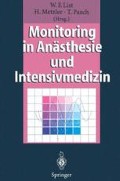Zusammenfassung
Umgebungsbedingte sowie anästhetikainduzierte Veränderungen der Körpertemperatur während längerdauernder chirurgischer Interventionen können den intra-und postoperativen Verlauf bei allen Patienten, in um so stärkerem Ausmaß jedoch bei Patienten extremer Altersgruppen (Kinder, geriatrische Patienten), erheblich komplizieren.
Access this chapter
Tax calculation will be finalised at checkout
Purchases are for personal use only
Preview
Unable to display preview. Download preview PDF.
Literatur
Benzinger TH (1969) Tympanic thermometry in surgery and anesthesia. JAMA 209:1207
Bissonette B (1992) Temperature monitoring in pediatric anesthesia. Int Anesthesiol Clin 30:63
Brinnel H, Cabanac M (1989) Tympanic temperature is a core temperature in humans. J Therm Biol 14:47
Brück K (1990) Wärmehaushalt und Temperaturregulation. In: Schmidt RF Thews G (Hrsg) Physiologie des Menschen, 24. Aufl. Springer, Berlin Heidelberg New York Tokyo, S 660–682
Ciofolo M, Clergue F, Devilliers C, Ammar M, Viars P (1989) Changes in ventilation, oxygen uptake and carbon dioxide output during recovery from isoflurane anesthesia. Anesthesiology 70:737
Conover MA, Lennon MA, Rose SH (1989) Evaluation of a forced-air patients warming system for hypothermic postsurgical patients. Anesth Analg 68:559
Cork RC, Vaughan RW, Humpherey LS (1983) Precision and accuracy of intraoperative temperature monitoring. Anesth Analg 62:211
Freysz M, Timour Q, Mazze R, Bertrix L, Cohen S, Samii K, Faucon G (1989) Potentiation by mild hypothermia of ventricular conduction disturbances and reentrant arrhythmias induced by bupivacaine in dogs. Anesthesiology 70:799
Gewolb J, Hines R, Barash PG (1987) Admission to the post anesthesia recovery room at a university teaching hospital. Anesthesiology 67: A 471
Hardy EB, Cirillo BL, Gutzeit MN (1988) Rewarming patients in the PACU: can we make a difference? J Post Anesth Nurs 3:313
Holdcroft A, Hall GM, Cooper GM (1979) Redistribution of body heat during anesthesia: a comparison of halothane, fentanyl and epidural anesthesia. Anesthesia 34:758
Horrow JC, Rosenberg H (1988) Does urinary temperature reflect core temperature during cardiac surgery. Anesthesiology 69:986
Imrie MM, Hall GM (1990) Body temperature and anesthesia. Br J Anesth 64:346
Keys TE (1963) The history of surgical anesthesia. Dover, New York
Morris RH, Wileky BR (1970) The effect of ambient temperature on patient temperature during surgery non involving body cavities. Anesthesiology 32:102
Moyaeri A, Hynson JM, Sessler DI, McGuire J (1991) Preinduction skin-surface warming prevents redistribution hypothermia. Anesthesiology 75:1004
Ohmura A, Wing KC, Westenskow DR (1979) Effect of hypocarbia and normocarbia on cardiovascular dynamics and circulation in the hypothermic dog. Anesthesiology 50:293
Phillips R, Skov P (1988) Rewarming and cardiac surgery: a review. Heart Lung 17:511
Scott AM (1967) Thermal blanket injury in the operating room. Arch Surg 94:151
Sessler DI, Stoen R, Closten B (1989) The Bair Hugger Warmer significantly decreases heat loss to the environment. Anesthesiology 71: A 411
Sessler DI, McGuire J, Hynson J, Moayeri A, Heier T (1992) Thermoregulatory vasoconstriction during isoflurane anesthesia minimally decreases cutaneous heat loss. Anesthesiology 76:670
Sessler DI, Rubinstein EH, Eger E II (1987) Core temperature changes during N20 fentanyl and halothane/O2 anesthesia. Anesthesiology 67:137
Sessler DI, Olofson CI, Rubinstein EH (1988) The thermoregulatory threshold in humans during halothane anesthesia. Anesthesiology 68:836
Sharkey A, Liptom JM, Murphy MT (1987) Inhibition of postanesthetic shivering with radiant heat. Anesthesiology 66:249
Sheffield CW, Hopf HW, Sessler DI, Hunt TK, West JM (1992) Thermoregulatory vasoconstriction decreases oxygen tension in anesthetized volunteers. Anesthesiology 77: 3A
Slotman GJ, Jed EH, Burchard KW (1985) Adverse effects of hypothermia in postoperative patients. Am J Surg 149:495
Valeri CR, Feingold H, Cassidy G, Ragno G, Khuri S, Altschule M (1987) Hypothermia induced reversible platelet dysfunction. Ann Surg 175:181
Vaughan VS, Vaughan RW, Cork RC (1981) Postoperative hypothermia in adults: relationship to age, anesthesia and shivering to rewarming. Anesth Analg 60:746
Vaughan MS (1984) Shivering in the recovery room. Curr Rev R R Nurse 6:2
Whitby JD, Duncan LF (1971) Cerebral, osophageal and nasopharyngeal temperatures. Br J Anesth 43:673
Editor information
Editors and Affiliations
Rights and permissions
Copyright information
© 1995 Springer-Verlag Berlin Heidelberg
About this chapter
Cite this chapter
Kröll, W. (1995). Körpertemperatur. In: List, W.F., Metzler, H., Pasch, T. (eds) Monitoring in Anästhesie und Intensivmedizin. Springer, Berlin, Heidelberg. https://doi.org/10.1007/978-3-662-08840-1_22
Download citation
DOI: https://doi.org/10.1007/978-3-662-08840-1_22
Publisher Name: Springer, Berlin, Heidelberg
Print ISBN: 978-3-662-08841-8
Online ISBN: 978-3-662-08840-1
eBook Packages: Springer Book Archive

